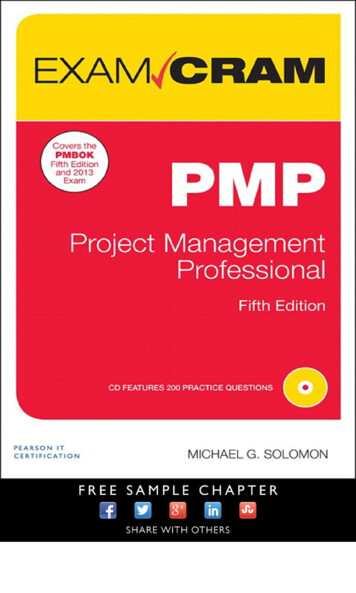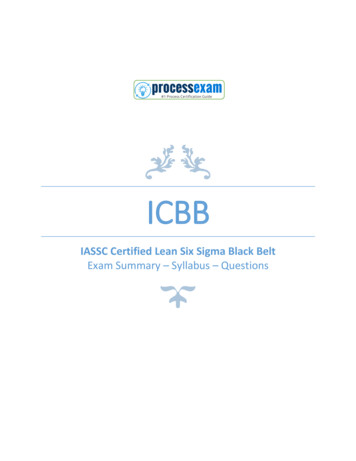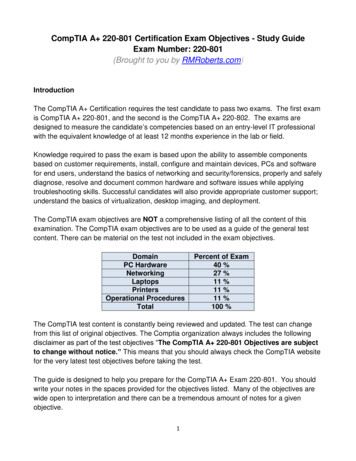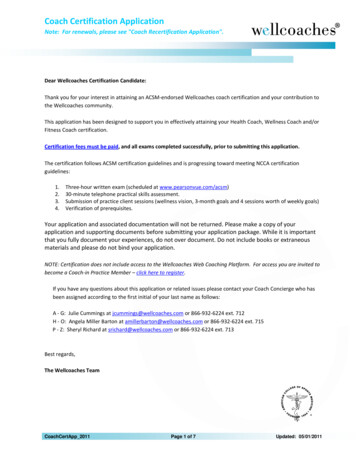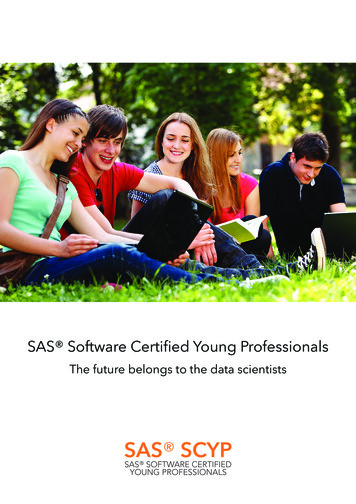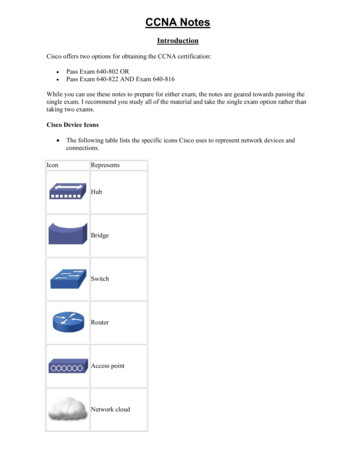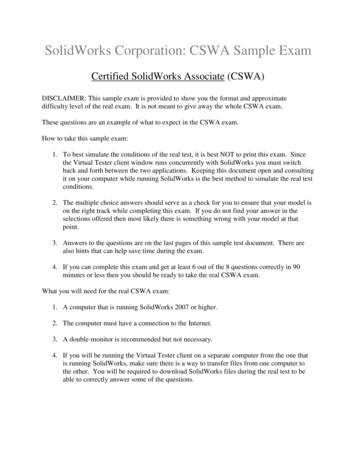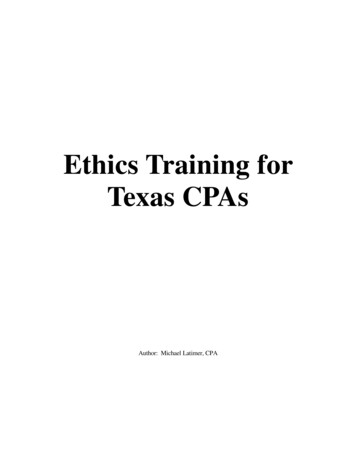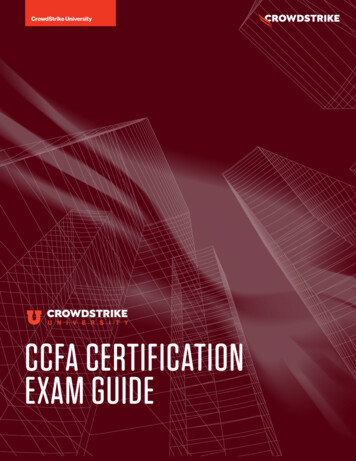
Transcription
CrowdStrike UniversityCCFA CERTIFICATIONEXAM GUIDELast Updated: Sept. 9, 20212021 CrowdStrike, Inc. All rights reserved.
CrowdStrike UniversityCCFA CERTIFICATION EXAM GUIDEDESCRIPTIONThe CrowdStrike Certified Falcon Administrator (CCFA) exam is the final step toward the completion of CCFAcertification. This exam evaluates a candidate’s knowledge, skills and abilities to manage various components of theCrowdStrike Falcon platform on a daily basis, including sensor installation.A successful CrowdStrike Certified Falcon Administrator: Understands user management and role-based permissionsDeploys and manages Falcon sensors and creates groups Configures deployment and prevention policy settingsConfigures allowlists and blocklists Configures exclusionsConducts administrative reportingCROWDSTRIKE CERTIFICATION PROGRAMREQUIREMENTSAll exam registrants must (no exceptions):Accept the CrowdStrike Certification Exam AgreementBe at least 18 years of agePurchase a CrowdStrike exam voucherContact your CrowdStrike Account Executive to request a quote or purchase a CrowdStrike exam voucher throughPearson VUE.UNIVERSITY SUBSCRIPTIONIt is strongly suggested that all exam registrants have an active subscription to CrowdStrike University and haveconfirmed access to their CrowdStrike University account. CrowdStrike certification-aligned courses are available to learners with an active CrowdStrike University account. A unique CrowdStrike Certification ID, training transcripts and printable certification documents are availablethrough CrowdStrike University learning management system.NOTE: All exam takers can view and print their CrowdStrike certification exam score report through Pearson VUE.REQUIRED CERTIFICATION CANDIDATE COMPETENCE AND ABILITIES Candidates should have at least six (6) months of experience with CrowdStrike Falcon in a production environment. Candidates should read English with sufficient accuracy and fluency to support comprehension. Exams aresuitable for non-native English speakers.Last Updated: Sept. 9, 20212021 CrowdStrike, Inc. All rights reserved.
CrowdStrike UniversityCCFA CERTIFICATION EXAM GUIDEABOUT THE EXAMASSESSMENT METHODThe CCFA exam is a 90-minute, 60-question assessment. Exam questions have been specifically written in a way thateliminates tricky wording, double negatives, and/or fill-in-the-blank type questions. This exam passed several roundsof editing by both technical and non-technical experts and has been tested by a wide variety of candidates.INITIAL CERTIFICATIONTo be eligible for certification, candidates must:Achieve passing score on the CCFA certification examRefrain from any misconductIn the event of misconduct by the candidate, CrowdStrike may invalidate the score and consider any suspicious actiona violation of the CrowdStrike Certification Exam Agreement.When a candidate has completed the exam and the candidate's official exam score has been posted, the certificationcandidate may view the official exam score at Pearson VUE.RETAKE POLICYCandidates who do not pass an exam on their first (1st) attempt:Must wait 48 hours to retake the exam (wait time begins after the exam) Should review the exam objectives, training course materials and associated recommended reading listed in thisdocument.After the second (2nd) attempt, a candidate will need to wait seven (7) days for the third (3rd) attempt and anysubsequent attempts. Wait time begins the day after the attempt.Candidates that want to retake the exam should consider re-sitting the applicable recommended course(s) and gainadditional experience with CrowdStrike Falcon before trying again.Retakes beyond the fourth (4th) attempt will be considered on a case-by-case basis. CrowdStrike reserves the right todeny a retake beyond the 4th attempt. If the 4th attempt is a failure due to a technical issue the student can reattemptfor a 5th time.If the student fails for a 4th time due to personal performance, they must wait 30 days and retake the recommendedtraining indicated in the exam guide. CrowdStrike will verify that the candidate has retaken the recommended trainingin the exam guide and has met with the CS Certification Manager before clearing him or her to register for a 5th examattempt.Retaking Previously Passed ExamsCandidates will not be permitted to retake any exam they have previously passed unless directly related to arecertification requirement approved by CrowdStrike.Beta ExamsCandidates will not be permitted to retake beta exams.Last Updated: Sept. 9, 20212021 CrowdStrike, Inc. All rights reserved.
CrowdStrike UniversityCCFA CERTIFICATION EXAM GUIDEEXAM CHALLENGEIf a certification candidate believes there is an error on an exam or that specific questions on the CCFA exam areinvalid, contact certification@crowdstrike.com to request an evaluation of your claim. The certification candidate mustsubmit a claim within three (3) days of taking the exam for it to be considered. CrowdStrike will generally respond toyour submission within fifteen (15) business days.RECERTIFICATIONCertification exams are not tied to product versions. The following lifecycle will apply to recertification moving forward,beginning with the date the certification was issued:CrowdStrike Certified Falcon Administrator (CCFA): 3 yearsCrowdStrike Certified Falcon Responder (CCFR): 3 yearsCrowdStrike Certified Falcon Hunter (CCFH): 3 yearsEXAM PREPARATIONRECOMMENDED TRAININGCrowdStrike strongly recommends that certification candidates complete these CSU LP-A: Falcon AdministratorCourses in CrowdStrike University AND attain six months practical experience to prepare for the CCFA exam. Thecourses listed below reflect the current learning path for the CrowdStrike Administration certification:C rowdStrike University Orientation FHT 100: Falcon Platform Architecture Overview FHT 101: Falcon Platform Technical Fundamentals FHT 102: Falcon Platform Onboarding ConfigurationF HT 104: Activity App FundamentalsF HT 105: Sensor Installation, Configuration and Troubleshooting FHT 106: Custom Dashboards FHT 107: Falcon Firewall ManagementF HT 121: Falcon Spotlight Fundamentals FHT 122: Falcon Discover FundamentalsF HT 160: Falcon for Mobile FHT 200: Falcon Platform For AdministratorsTo learn more about these courses, view the CrowdStrike Training Catalog. CrowdStrike also recommends thatcandidates physically access the Falcon console and perform the exam objectives listed below to prepare for theexam.Last Updated: Sept. 9, 20212021 CrowdStrike, Inc. All rights reserved.
CrowdStrike UniversityCCFA CERTIFICATION EXAM GUIDERECOMMENDED READINGCrowdStrike strongly recommends certification candidates review the following CrowdStrike Falcon SupportDocumentation titles to prepare for the CCFA exam:Falcon Administration GuidesFalcon Console User GuideUsers and RolesCustomizable DashboardsFalcon NotificationsSingle Sign-OnEndpoint Security GuidesStart Up and Scale UpHost and Host Group ManagementDetection and Prevention PoliciesReal Time Response and Network ContainmentDevice ControlFalcon Firewall ManagementSensor Deployment and Maintenance Guides Falcon Sensor for Windows/Mac/Linux (excluding 5.x for Mac/Container/Mobile/Identity Protection/HomeUse/Cloud Workloads)Cloud IP AddressesSensor Update PoliciesEXAM SCOPEThe following topics provide a general guideline for the content likely to be included on the exam; however, otherrelated topics may also appear on any specific delivery of the exam.1.User Management2.Sensor Deployment3.Host Management4.Group Creation5.Prevention Policies6.Custom IOA Rules7.Sensor Update Policies8.Quarantine Files9.IOC Management10.Containment Policies11.Exclusions12.Firewall PoliciesLast Updated: Sept. 9, 20212021 CrowdStrike, Inc. All rights reserved.
CrowdStrike UniversityCCFA CERTIFICATION EXAM GUIDE13.Falcon Reports14.USB Policies15.Real Time Response Policies16.API Clients and Keys Reporting17.Notification WorkflowSCOPE CHANGESIn order to better reflect the content of the exam and for clarity purposes, the guidelines below may change at any timewithout notice. Such changes may include, without limitation, adding or deleting an available CrowdStrike certification,modifying certification requirements, and making changes to recommended training courses, testing objectives,outline and exams, including, without limitation, how and when exam scores are issued. The certification candidateagrees to meet (and continue to meet) the program requirements, as amended, as a condition of obtaining andmaintaining the certification.EXAM OBJECTIVESThe following subtopics and learning objectives provide further guidance on the content and purpose of the exam:1.0 USER MANAGEMENT1.1 Determine roles required for access to features and functionality in the Falcon console1.1.1Describe the capabilities and limitations of each Real Time Response (RTR) role1.1.2Create a new user, delete a user and edit a user, etc.2.0 SENSOR DEPLOYMENT2.1Analyze the pre-installation OS/networking requirements prior to installing the Falcon sensor2.2Analyze the default policies and apply best practices in order to prepare workloads for the Falcon sensor2.3Apply appropriate settings to successfully install a Falcon sensor on Windows, Linux and macOS2.3.1Apply basic sensor install requirements and installation processes2.3.2Apply additional/advanced options for images/VDI's, tokens and tags2.4Uninstall a sensor2.5Troubleshooting2.5.1 Recognize issues with the basic configuration requirements in the system environment or Falconcomponents2.5.2Resolve policy settings, permissions and threshold issues2.5.3Conduct root cause analysis related to system/user issuesLast Updated: Sept. 9, 20212021 CrowdStrike, Inc. All rights reserved.
CrowdStrike UniversityCCFA CERTIFICATION EXAM GUIDE3.0 HOST MANAGEMENT3.1Propose how filtering might be used in the Host Management page3.2Disable detections for a host3.3Explain the effect of disabling detections on a host3.4Explain the impact of reduced functionality mode (RFM) and why it might be caused3.5Find hosts in RFM3.6Find inactive sensors3.7Recall how long inactive sensors are retained in order to define your organization’s data backup plan3.8Determine which reports to use when reporting on information relating to a host3.9Explain the importance of understanding your company’s' Falcon Insight data retention timeframe4.0 GROUP CREATION4.1 Determine the appropriate group assignment for endpoints and understand how this impacts theapplication of policies4.1.2Describe policy types, components, application and workflow4.1.3Define precedence, groups and best practices5.0 PREVENTION POLICIES5.1 Determine the appropriate prevention policy settings for endpoints and explain how this impacts securityposture5.1.1 Demonstrate what the default policy is used for and apply best practices when configuring defaultpolicies5.1.2Configure a detection-only policy5.1.3Explain what Machine Learning is "on sensor" versus “the cloud”5.1.4Describe what each of the different policy setting options do5.1.5Define NextGen AV Settings5.1.6Describe what End User Notifications do5.1.7Assign a prevention policy to groups and hosts5.1.8Explain what precedence does regarding prevention policies5.1.9Describe policy best practices6.0 CUSTOM IOA RULES6.1Create custom IOA rules to monitor behavior that is not fundamentally maliciousLast Updated: Sept. 9, 20212021 CrowdStrike, Inc. All rights reserved.
CrowdStrike UniversityCCFA CERTIFICATION EXAM GUIDE7.0 SENSOR UPDATE POLICIES7.1 Determine the appropriate sensor update policy settings and related general settings in order to control theupdate process7.1.1Define an update policy7.1.2 Demonstrate what the default policy is used for and apply best practices when configuring defaultpolicies7.1.3Describe what auto-update does7.1.4Explain separate policies for MAC/Win/*nix7.1.5Explain where build versions are visible for a single sensor or across your environment7.1.6Describe what precedence does regarding sensor update policies8.0 QUARANTINE FILES8.1Apply options required to manage quarantine files9.0 IOC MANAGEMENT9.1Assess IOC settings required for customized security posturing and to manage false positives10.0 CONTAINMENT POLICY10.1 Configure an allowlist of the appropriate IP addresses, while the network is under containment, based onsecurity workflow requirements10.2Describe what a containment policy does10.3Allowlist network traffic so it can connect to contained hosts11.0 EXCLUSIONS11.1 Interpret business requirement in order to allow trusted activity and resolve false positives and performanceissues11.1.1Write an effective file exclusion rule using glob syntax11.1.2Apply File Pattern Exclusions to groups11.1.3Demonstrate how to manage exclusion rules12.0 FIREWALL POLICIES12.1Describe how to create a firewall policy12.2Describe how to configure rule groups, configure traffic rules and apply rule groups to firewall policiesLast Updated: Sept. 9, 20212021 CrowdStrike, Inc. All rights reserved.
CrowdStrike UniversityCCFA CERTIFICATION EXAM GUIDE13.0 FALCON REPORTS13.1Explain the different types of sensor reports and what each report provides13.1.1Explain what information is contained in Machine-Learning Prevention Monitoring Report13.1.2Explain what information is in the Falcon UI Audit Trail Report13.1.3 Explain what information is in the API Audit Trail, Prevention Policy Audit Trail, PreventionHashes Ignored Reports13.1.4Explain what information is in the Prevention Policy Debug Report13.1.5Explain what information a Linux Sensor Report will provide13.1.6Explain what information a Mac Sensor Report will provide13.1.7Explain the differences between the Visibility and Hunting reports13.1.8Explain the information shown in the Logon Activity Report13.1.9Explain the information shown in the Remote Logon Activity Report13.1.10Explain the information shown on the Remote Access Graph Report13.1.11Explain the information shown on the Geo Location Activity Report13.1.12Explain what information can be found in Visibility Reports13.1.13Write an effective custom alert rule14.0 USB POLICIES14.1Apply a USB device policy to restrict or allow access to USB devices14.1.1Create granular device policies14.1.2Allowlist and blocklist devices by class, vendor and serial name14.1.3Define policies for host groups14.1.4Adjust the device control settings14.1.5 Demonstrate what the default policy is used for and apply best practices when configuringdefault policies14.1.6Describe what precedence does regarding USB device control policies15.0 REAL TIME RESPONSE POLICY15.1Apply roles and policy settings, and track and review RTR audit logs in order to manage user activity16.0 API CLIENTS AND KEYS16.1Manage API Keys17.0 NOTIFICATION WORKFLOW17.1Configure custom alerts to notify individuals about policies, detections and incidentsLast Updated: Sept. 9, 20212021 CrowdStrike, Inc. All rights reserved.
CCFA CERTIFICATION EXAM GUIDE DESCRIPTION The CrowdStrike Certified Falcon Administrator (CCFA) exam is the final step toward the completion of CCFA certification. This exam evaluates a candidate’s knowledge, skills and abilities to manage various components of the CrowdStrike Falcon


